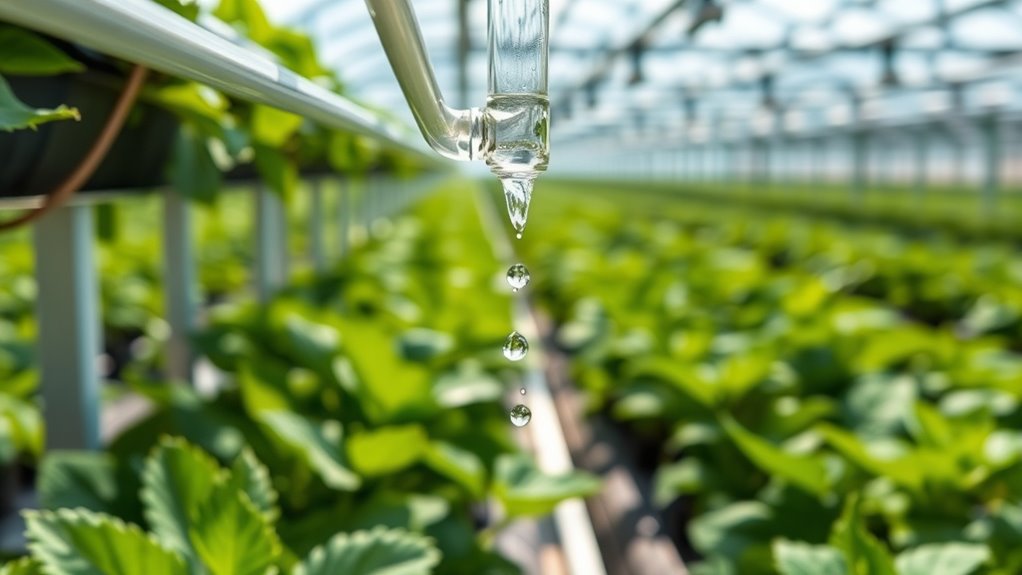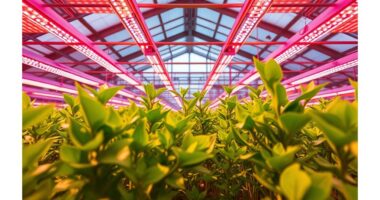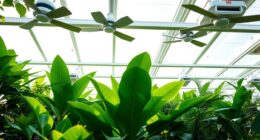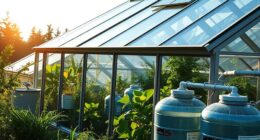Fertigation techniques allow you to deliver nutrients directly to your greenhouse plants through an integrated watering system. By combining fertilization and irrigation, you can precisely supply essential nutrients at the root zone, improving plant health while minimizing waste. Incorporating soil amendments and pest management options further enhances growth and protection. Using real-time monitoring ensures you adjust feedings as needed, maintaining ideal conditions. Keep exploring to discover how these strategies can maximize your greenhouse’s productivity and health.
Key Takeaways
- Combines fertilization and irrigation for targeted, efficient nutrient delivery directly to plant roots.
- Utilizes soil amendments to improve structure, water retention, and nutrient availability for healthier plants.
- Incorporates pest control agents into watering systems, reducing chemical pesticide reliance and promoting ecosystem health.
- Employs sensors and automation to monitor soil moisture and nutrients, enabling precise, real-time adjustments.
- Supports overall plant and soil health by preventing nutrient imbalances and pest outbreaks through integrated management.

Fertigation is a highly efficient method that combines fertilization and irrigation to supply nutrients directly to plants through the watering system. This technique allows you to deliver precise amounts of nutrients right at the root zone, minimizing waste and enhancing plant growth. When setting up your fertigation system, you should consider how soil amendments can improve nutrient availability and soil health. Adding organic matter or mineral-based soil amendments helps improve the soil’s structure, water retention, and nutrient-holding capacity. A well-amended soil creates a more stable environment for roots, reducing nutrient leaching and ensuring plants receive a steady supply of essential elements through fertigation. By integrating soil amendments into your fertilization routine, you promote healthier root systems and reduce the risk of nutrient deficiencies that could hamper plant development.
In addition to nutrient delivery, fertigation plays a significant role in pest management. Because you can control the timing and composition of the nutrients and any added solutions, you have the opportunity to include pest control agents or organic repellents directly into the watering system. This targeted approach lessens the need for broad-spectrum chemical applications, which can harm beneficial insects and the surrounding environment. For example, you might incorporate natural compounds like neem oil or biological controls into the fertigation schedule, providing a dual benefit of nourishing your plants while warding off pests. This method ensures that pest management is integrated seamlessly into your overall crop care, reducing the reliance on traditional pesticides and promoting a healthier greenhouse ecosystem.
Furthermore, fertigation facilitates real-time monitoring and adjustments. Using sensors and automated systems, you can precisely measure soil moisture and nutrient levels, adjusting the fertilizer solution accordingly. This means you’re not just blindly applying nutrients but tailoring the process based on actual plant needs. This precision minimizes over-fertilization, which can lead to nutrient imbalances and pest outbreaks, and under-fertilization, which stunts growth. It also helps maintain ideal soil health by preventing excess salts and chemical buildup, consequently reducing potential pest habitats associated with unhealthy or stressed plants. By paying close attention to soil amendments and integrating pest management strategies into your fertigation routine, you foster a thriving, resilient greenhouse environment.
Frequently Asked Questions
What Are the Cost Implications of Implementing Fertigation Systems?
Implementing fertigation systems involves some initial investment in equipment and setup costs, but it can save you money over time by reducing fertilizer waste and improving crop yields. Maintenance costs are generally manageable, especially if you keep the system well-maintained. While upfront expenses may seem high, the efficiency gains and precise nutrient delivery can offset costs in the long run, making it a worthwhile investment for your greenhouse.
How Does Fertigation Impact Water Conservation Efforts?
Fertigation boosts your water efficiency by delivering precise amounts directly to plant roots, reducing runoff and evaporation. This targeted approach minimizes water waste, helping you conserve water resources effectively. Additionally, fertigation promotes nutrient savings because you apply fertilizers accurately, avoiding overuse and leaching. As a result, you can achieve healthier plants with less water and fewer nutrients, supporting sustainable practices and lowering long-term costs.
Can Fertigation Be Used for All Types of Greenhouse Plants?
You can use fertigation for most greenhouse plants, but plant compatibility varies. Studies show that up to 85% of plants respond well to fertigation when the system is flexible enough to adapt to different nutrient needs. This means you can tailor your approach, adjusting for plant type and growth stage. However, always check specific requirements to guarantee peak health and productivity, making your fertigation system both versatile and effective.
What Are Common Troubleshooting Issues With Fertigation Systems?
You might face troubleshooting issues like system clogs or uneven distribution with your fertigation setup. Regularly check filters and nozzles to prevent clogs, and guarantee your pump operates smoothly. To attain even distribution, calibrate your system periodically and monitor flow rates. If problems persist, inspect for leaks or blockages in the lines. Addressing these issues promptly helps maintain ideal plant health and consistent nutrient delivery.
How Often Should Nutrient Concentrations Be Adjusted During Fertigation?
You should adjust nutrient concentrations based on your plants’ growth stage and nutrient timing needs, typically every one to two weeks. Regularly monitor plant health and environmental conditions to determine when concentration adjustments are necessary. Keep an eye on nutrient uptake and deficiencies, and fine-tune your fertigation system accordingly. This proactive approach ensures ideal nutrient delivery, promotes healthy growth, and prevents over- or under-fertilization.
Conclusion
Now that you know how fertigation enables precise plant feeding, aren’t you enthusiastic to implement these techniques in your greenhouse? By combining accurate nutrient delivery with your daily care, you’ll see healthier, more vigorous plants thrive. Isn’t it worth optimizing your watering system to give your plants exactly what they need, when they need it? Start applying these fertigation methods today and watch your greenhouse flourish like never before.









